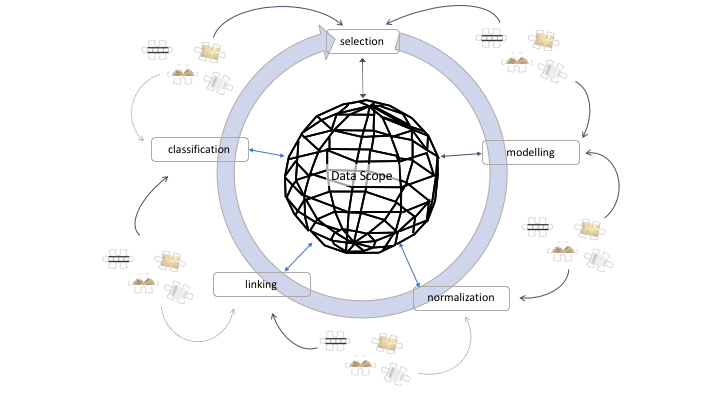Data Scopes
- Coherent methods for using digital data in humanities research
- Data scope: you want to analyse a certain aspect of your materials,
- but the “raw” data is not suitable for direct analysis.
- You have to do something with the data. Questions:
- What do I have to do to make data suitable?
- How do I do that?
- What should I document of this process to I can share it with others?
- Which parts of this process are specific to my analysis and which are generically applicable?
Example: project Legal Structures
- Analyse networks of internal references in national constitutions
- Investigate relations between network structure and legal, social and political variables
- visualized networks look great and show very suggestive patterns,
- but how do you know what you’re looking at?
- Questions:
- Which constitutions? Only current or only first or all versions? What counts as a version?
- When are two constitutions representing the same country?
- What do you do with countries changing names? What do you do with countries channging borders?
- What elements are we identifying in each constitution? References, logical structure of constitutions (individual articles, sections, chapters, …)
- Only internal references or also external? What counts as a reference?
- Do we treat references to individual articles the same as references to entire chapters? What about references to ranges of articles?
Focus on data interactions
- It’s not about specific tools
- Many tutorials online for that, e.g. the excellent Programming Historian
- It’s about what you’re doing, how and why
- Translating research questions, assumption and interpretations to data interactions
- Consequences of interactions for questions, assumptions and interpretations
Frameworks
- Data Scope: select, model, normalise, link, classify
- Other models focusing on process:
- Scholarly Primitives (John Unsworth): discover, annotate, compare, refer, sample, illustrate, represent
- Data Visualization (Ben Fry): acquire, parse, filter, mine, represent, refine, interact
Data Scope Schema

Modelling
- “Heuristic process of constructing and manipulating models” (McCarty, 2004)
- Model:
- “a representation of something for purposes of study,”
- “or a design for realizing something new”
- Model determines what aspects of data to focus on
- Structures data in sources around research focus
- Transforms data, affects interpretation!
Data axes
- Defining data axes:
- Persons, organisations, locations, dates, topics,
- Themes, life courses, events, actions, decisions
- Defining categories or classes along those axes:
- Roles of people and organisations
- Periods, regions
- Research stages:
- Model is updated as research progresses
- This updating reflects growing insights
Selecting
- Which materials do I include? Which data elements do I focus on?
- Data axes
- Algorithmic selection:
- Everything matching a (set of) keyword(s)
- Documents by type, creator, title, size, …
- What are consequences of these selections?
- What am I excluding?
Normalizing
- Bringing surface forms expressed in data back to an underlying standard form
- Map variation onto a single representation:
- E.g. linguistic variation, geographical and spatial variation
- What is irrelevant variation?
- Essential for next step: linking
Linking
- Establishing explicit connections between objects in the data sources that are not there from the beginning
- Connecting representations of a single element across different documents or data sets
- Connection different elements through relations
- Linking within a corpus:
- Relations between people, between people and events, between topics and dates, …
- Linking across different corpora:
- E.g. mentions of same person, location, date, …
- Can bring together disparate data about single entity from different sources
- Allows querying across different types of source materials
Classifying
- Reduction of complexity by grouping (data) objects into predefined categories, or classes
- Bringing together objects with similar properties
- Separating objects with unlike
- Adds new layers of structure and interpretation to data
- Especially useful for low-frequency items
- Many data axes have “long tails” which are hard to structure
- Facets
- multiple, indepdent classifications that can be combined
- allows very flexible selection and querying
Domain and subject expertise
- All these activities require both:
- Technical know-how of how digital tools handle data
- Intimate knowledge of the domain and subject of source materials
- But also:
- Reflection on how choices are informed by prior knowledge and experience
- Reflection on how choices put emphasis on some aspects, while pushing back others
- Often requires collaboration…
- How to organise that
- … and lots of discussion
- Choices that one collaborator makes should be visible to the rest
#